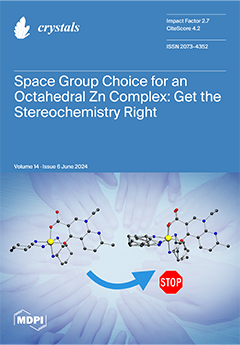The electronic properties of calcium-intercalated graphite (CaC
6) as a function of pressure are revisited using density functional theory (DFT). The electronic band structures of CaC
6, like many other layered superconducting materials, display cosine-shaped bands at or near the Fermi
[...] Read more.
The electronic properties of calcium-intercalated graphite (CaC
6) as a function of pressure are revisited using density functional theory (DFT). The electronic band structures of CaC
6, like many other layered superconducting materials, display cosine-shaped bands at or near the Fermi level (FL). Such bands encompass bonding/antibonding information with a strong connection to superconducting properties. Using a hexagonal cell representation for CaC
6, the construction of a double supercell in the
c-direction effects six-folding in the reciprocal space of the full cosine function, explicitly revealing the bonding/antibonding relationship divide at the cosine midpoint. Similarly, folding of the Fermi surface (FS) reveals physical phenomena relevant to electronic topological transitions (ETTs) with the application of pressure. The ETT is characterised by a transition of open FS loops to closed loops as a function of pressure. As the highest transition temperature is reached with pressure, the dominant continuous, open FS loops shift to a different region of the FS. For CaC
6, the peak value for the superconducting transition temperature, T
c, occurs at about 7.5 GPa, near the observed pressure of the calculated ETT. At this pressure, the radius of the nearly spherical Ca 4s-orbital FS coincides with three times the distance from the
Γ centre point to the Brillouin zone (BZ) boundary of the 2
c supercell. In addition, the ETT coincides with the alignment of the nonbonding (inflection) point of the cosine band with the FL. At other calculated pressure conditions, the Ca 4s-orbital FS undergoes topological changes that correspond and can be correlated with experimentally determined changes in T
c. The ETT is a key mechanism that circumscribes the known significant drop in T
c for CaC
6 as a function of increasing pressure. Consistent calculated responses of the ETT to pressure match experimental measurements and validate the examination of superlattices as important criteria for understanding mechanisms driving superconductivity.
Full article





